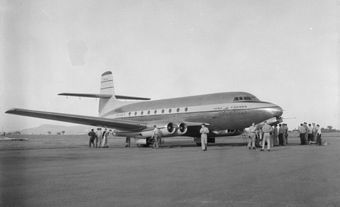The Canadair CL-28 Argus was a long-range maritime patrol plane built in Canada. When it entered service with the Royal Canadian Air Force (RCAF) in 1957, it was the most advanced anti-submarine aircraft in the world. After unification of the Canadian Armed Forces in 1968, the CL-28 was re-designated as the CP-107. It was replaced in the early-1980s by the CP-140 Lockheed Aurora.

Context
In the early 1950s, the RCAF needed a long-range maritime patrol aircraft (LRPA) to monitor Soviet Cold War submarine activity in the Atlantic and Pacific Oceans. The new aircraft would replace the aging Avro Lancaster bomber and the Lockheed Neptune medium-range patrol aircraft in the antisubmarine warfare (ASW) role.
Design
Canadair adapted the basic design from the British Bristol Britannia airliner transport aircraft. It was extensively modified to handle the greater stresses of violent low-altitude manoeuvres and was the first aircraft to make extensive use of titanium in the main structure components. The aircraft was also “Canadianised” with high-power but low fuel consumption Wright radial engines and other standard American parts in place of British materials; this made maintenance easier. Canadair also completely re-designed the Britannia fuselage, sacrificing a pressurized cabin to accommodate two long bomb bays fore and aft of the wings that could carry up to 8,000 lbs (3,600 kg) mix of torpedoes, depth charges, bombs and sonobuoys.
With a range of over 5,000 miles (8,000 km) the aircraft had a normal patrol endurance of 18 hours, although it was rated for 26.5 hours fully loaded. On 1–2 October 1959, an Argus set a Canadian record of 31 hours for the longest flight without refuelling. Due to the length of these patrols, the Argus had an operational crew of 15: two pilots, a flight engineer and a navigator (and a relief crew of four for these positions), and another seven specialists to operate the range of electronic sensors. The aircraft also included four crew bunks and a galley.
What distinguished the Argus from other ASW aircraft then in service, besides its superior endurance, was its comprehensive avionics fitted specifically for the ASW role. These included a long-range, high-definition radar to search for submarine periscopes; a 70 million candlepower searchlight for nighttime searches; a magnetic anomaly detector (MAD) on an extended tail boom to measure iron-based metals from a submerged submarine; radio direction finding and pulse identification sensors to triangulate and identify vessel transmissions; and "Jezebel " Low Frequency Analyzer and Recorders (LOFAR) to allow onboard processing of submarine “noise” signals relayed from its sonobuoys.
Operational Role
Canada and its allies used the top-secret SOSUS (Sound Surveillance System), a network of passive sonar stations, to listen for submarine activity. By comparing bearings from the different stations, analysts could triangulate a fairly precise location for the submarine. An Argus could then be "cued " or despatched to the area, where it would deploy its own sonobuoys to process and localize the signals. It would then confirm the contact with a MAD “run” to continue more accurate tracking of the submarine.

Service
A total of 33 aircraft were constructed in Canadair’s Montreal facility: 13 of the Mark 1 and 20 Mk 2s (the main difference being improvements to internal avionics). Despite the clear success of the design, they were never exported for use by other allied forces, which preferred to support their own aircraft industries.
Did you know?
When the Argus was constructed, it was the largest aircraft built in Canada at the time.
The Argus first flew in March 1957 and was the mainstay of the RCAF ASW force for over two decades. The last Argus was withdrawn from service in 1982. They operated primarily from bases at Greenwood, Nova Scotia; Summerside, Prince Edward Island; and Comox, British Columbia. The Argus was replaced by the American-built CP-140 Lockheed Aurora, a derivative of the P-3 Orion. An example of the Argus is at the Canada Aviation and Space Museum in Ottawa.

 Share on Facebook
Share on Facebook Share on X
Share on X Share by Email
Share by Email Share on Google Classroom
Share on Google Classroom

